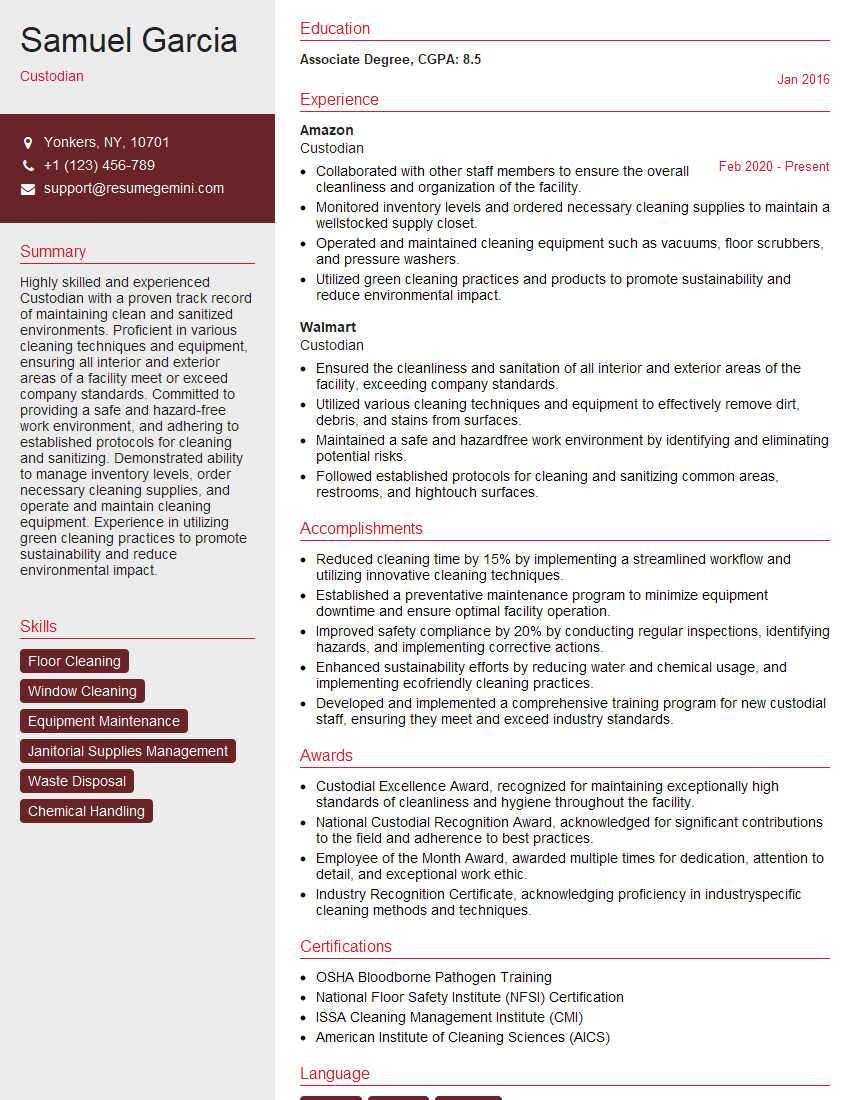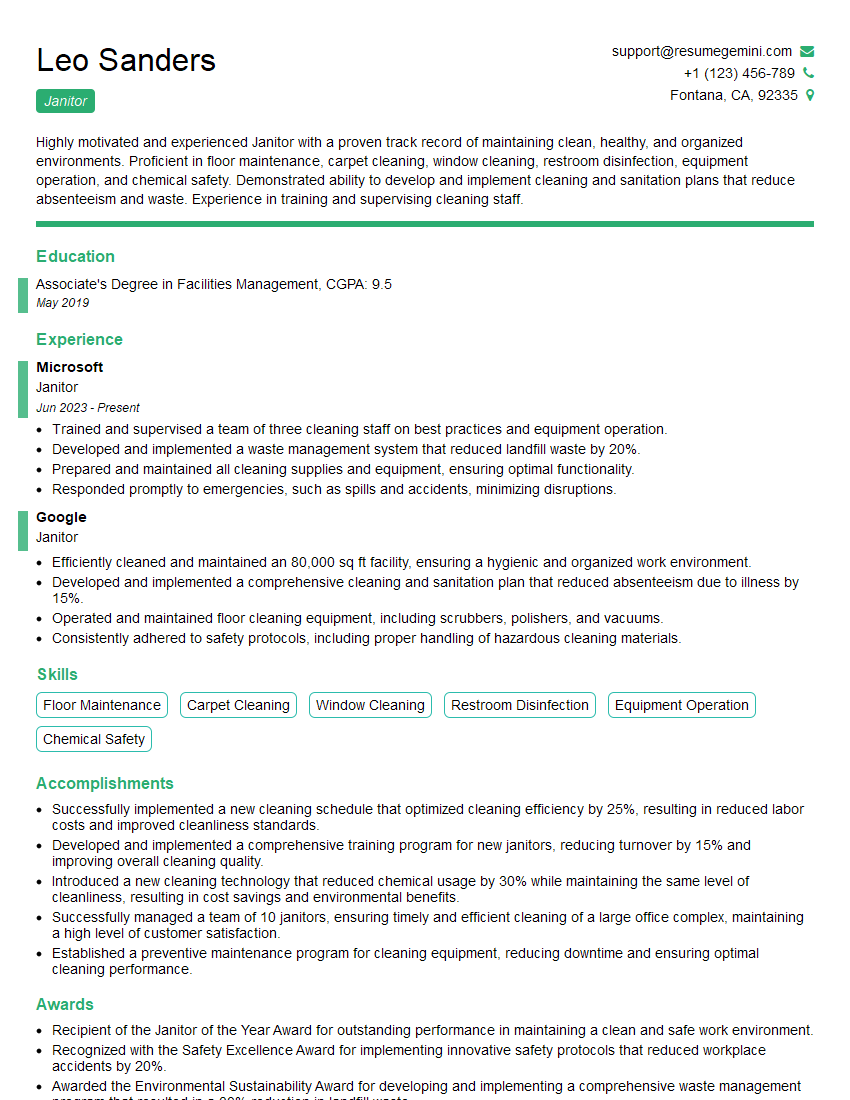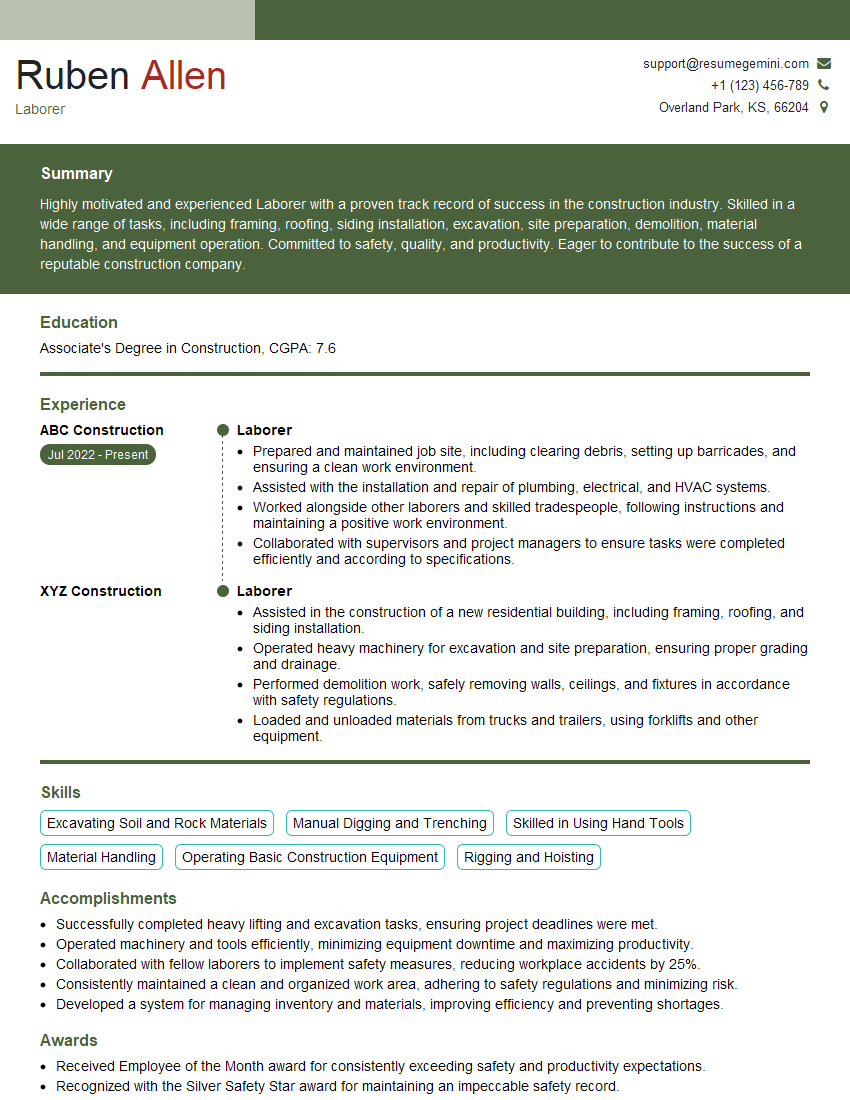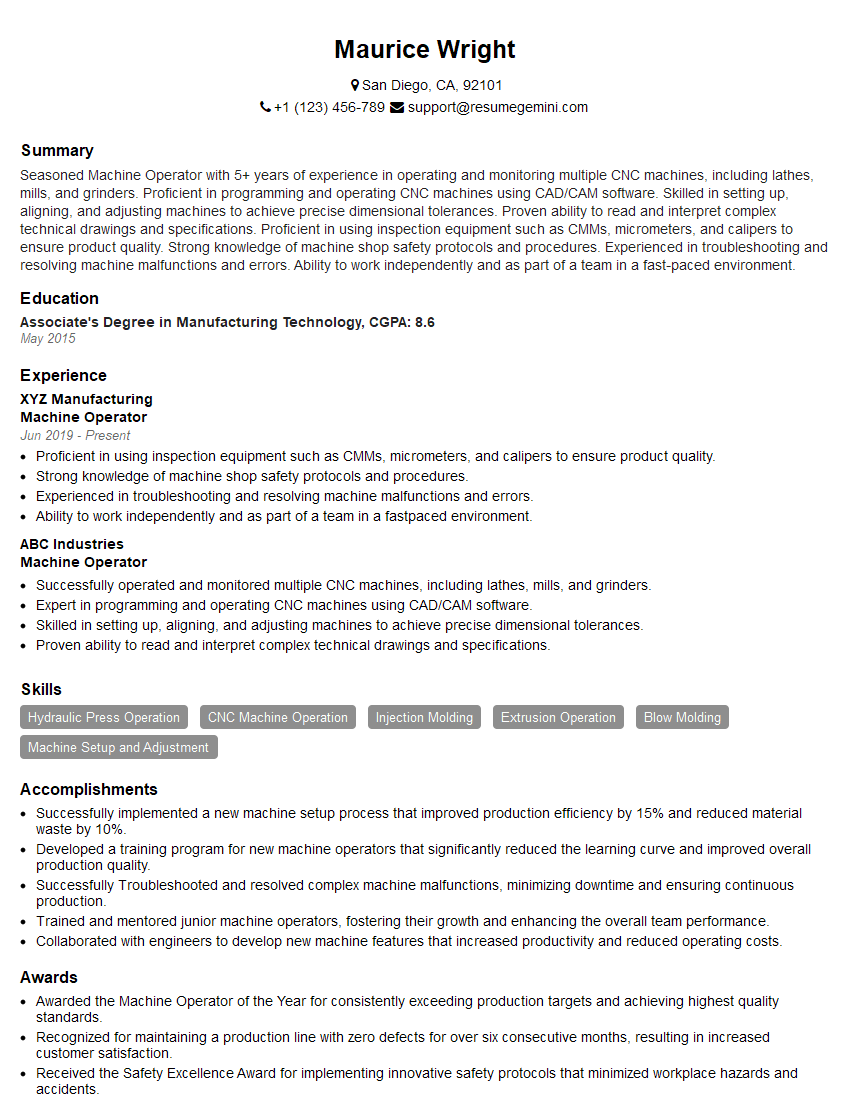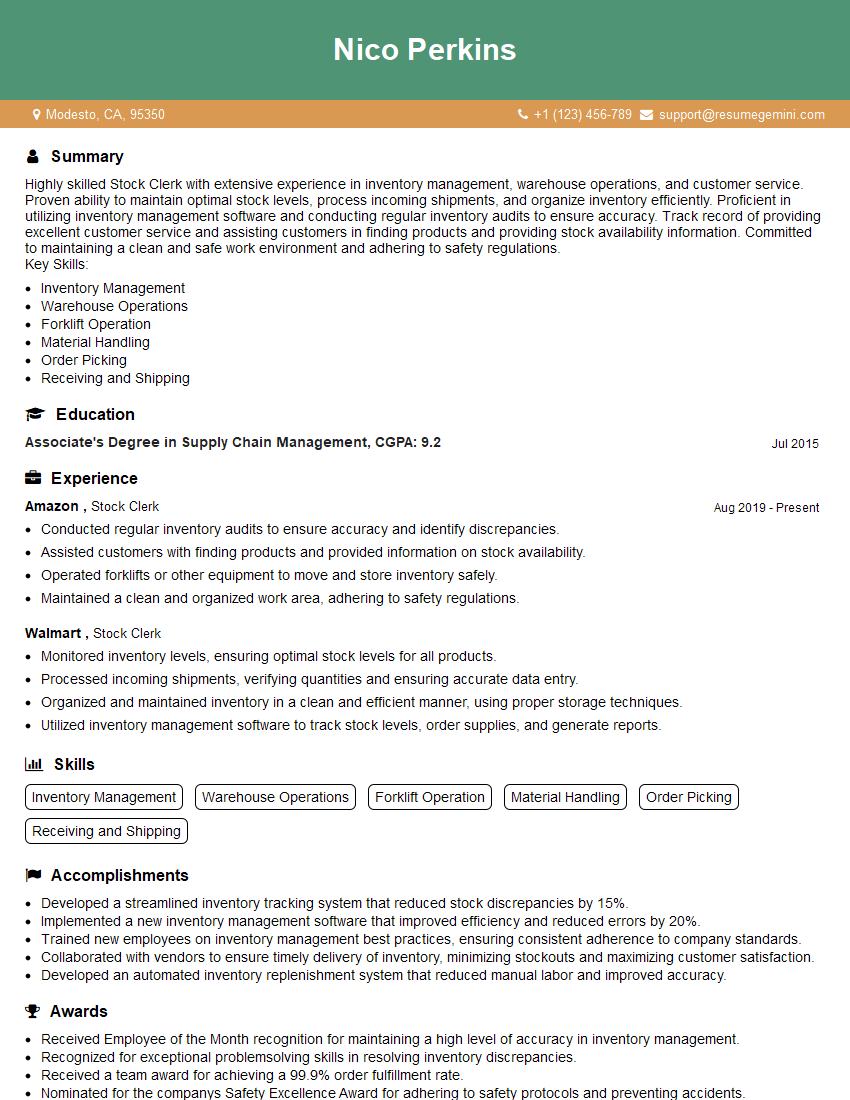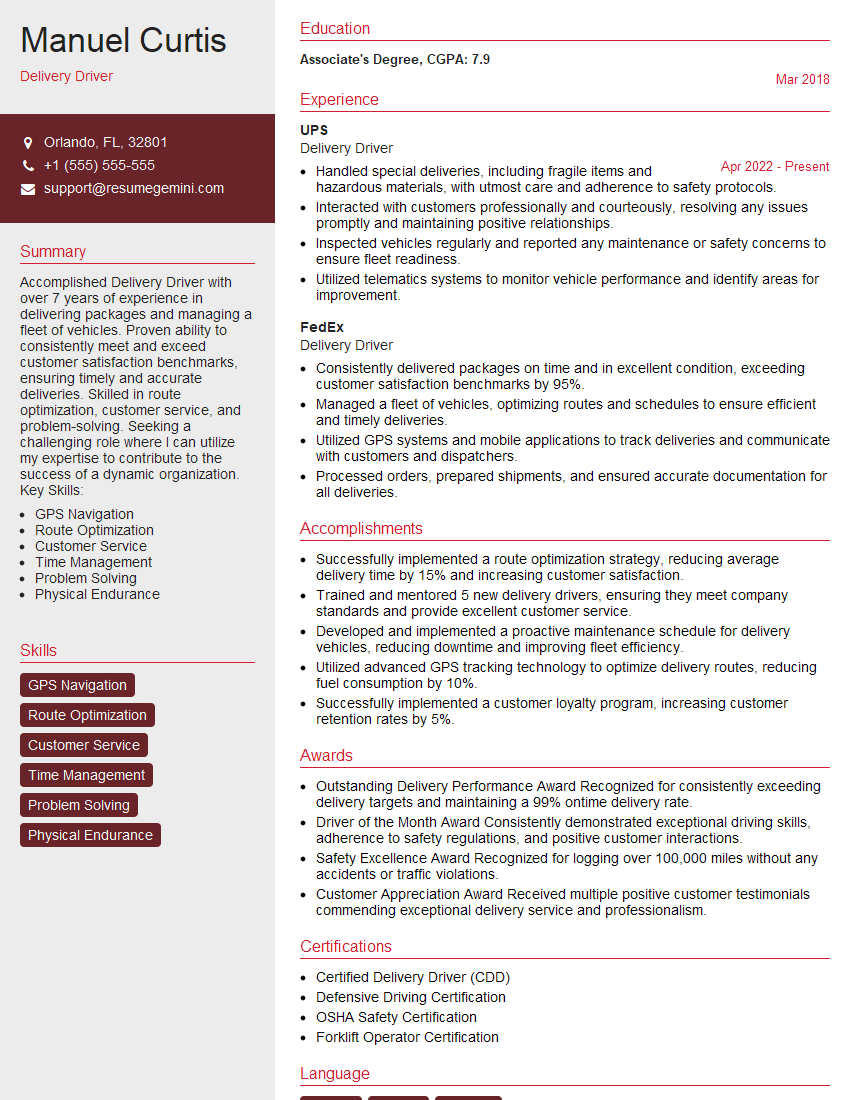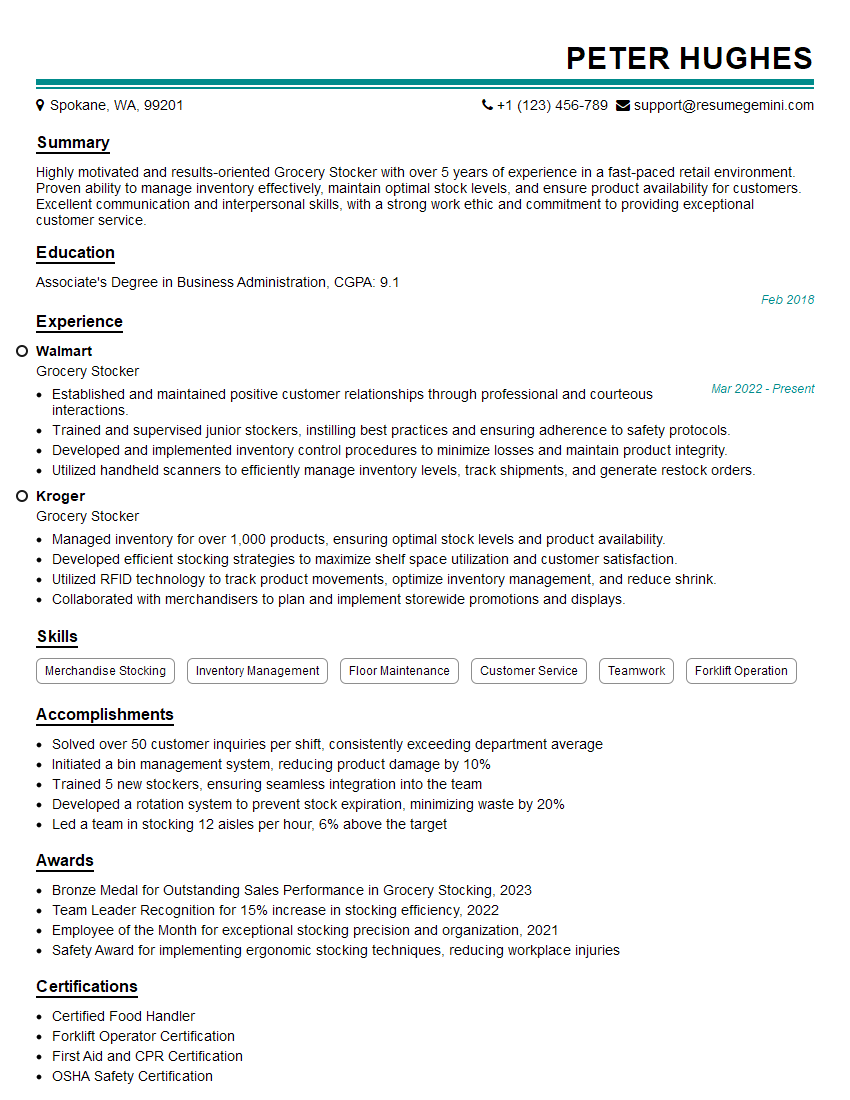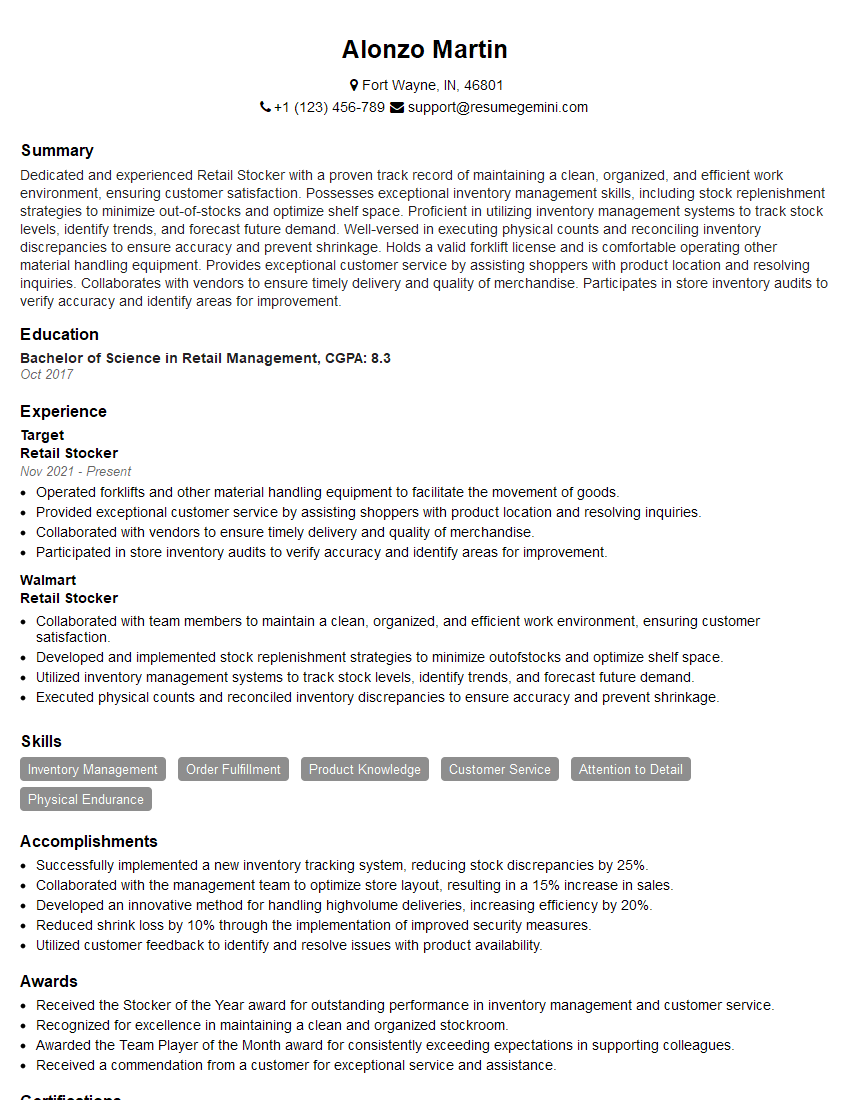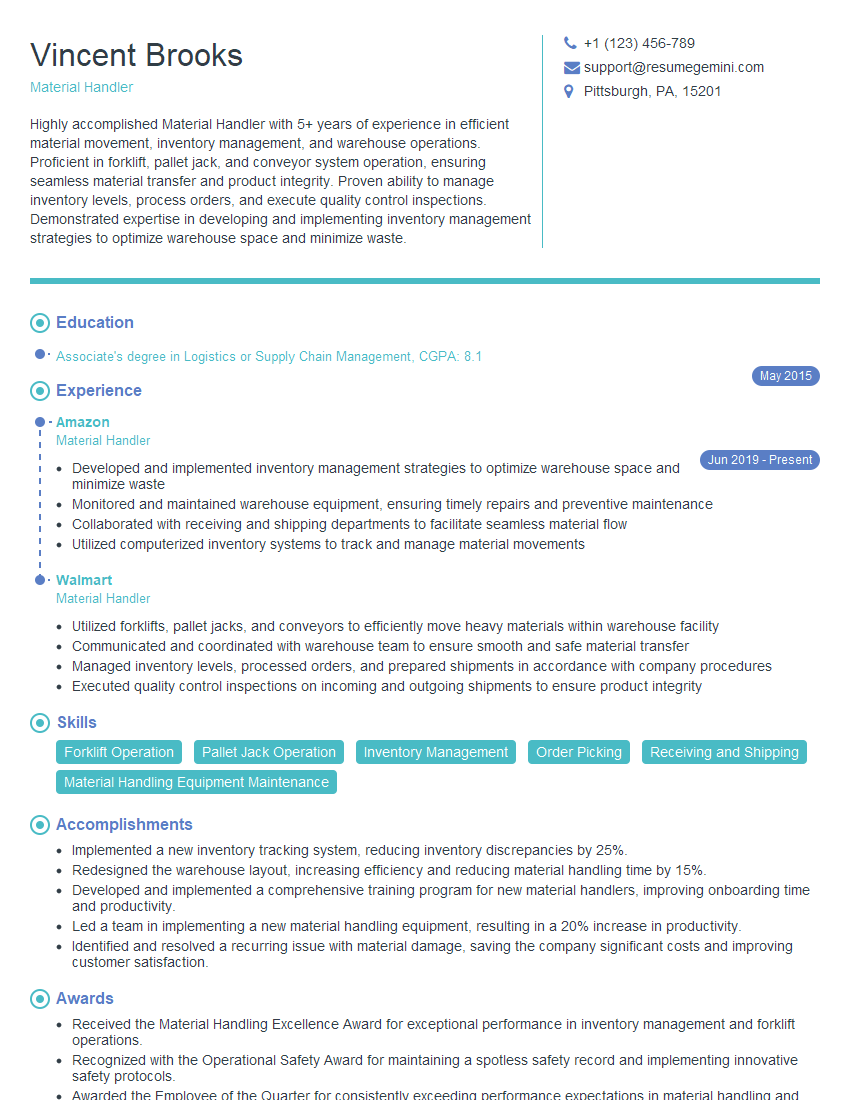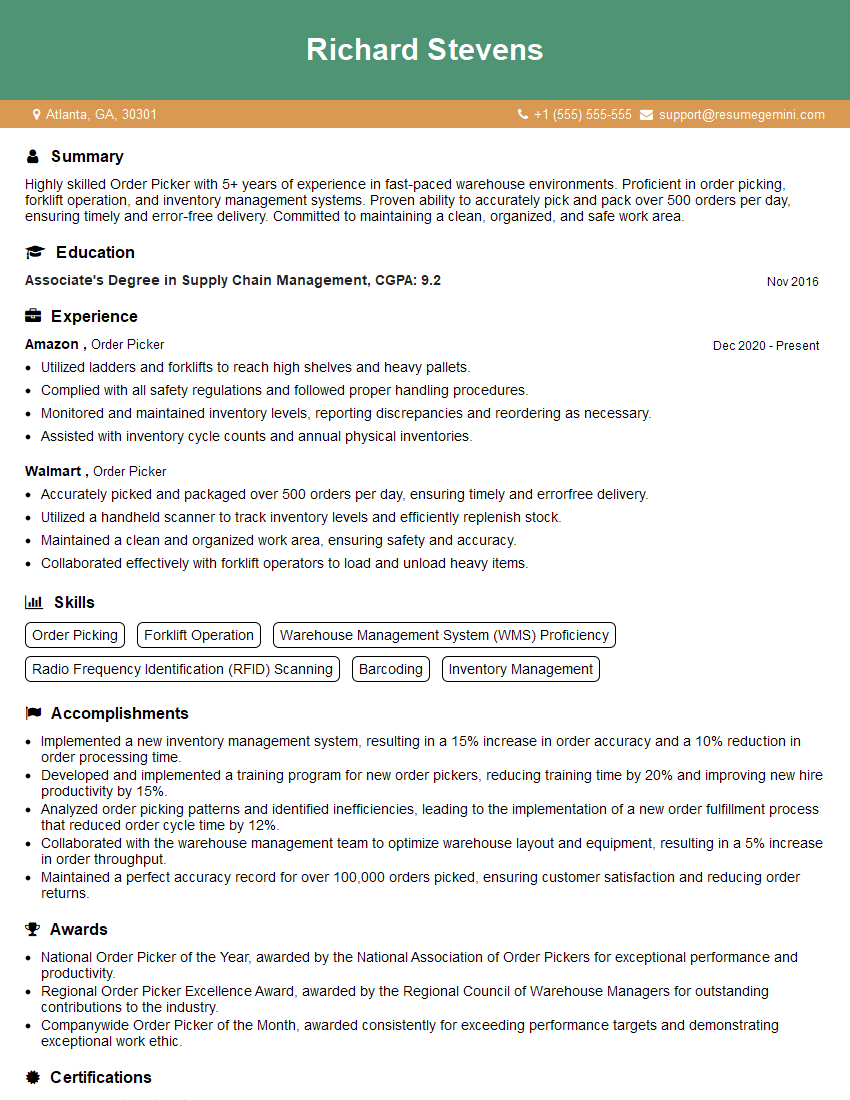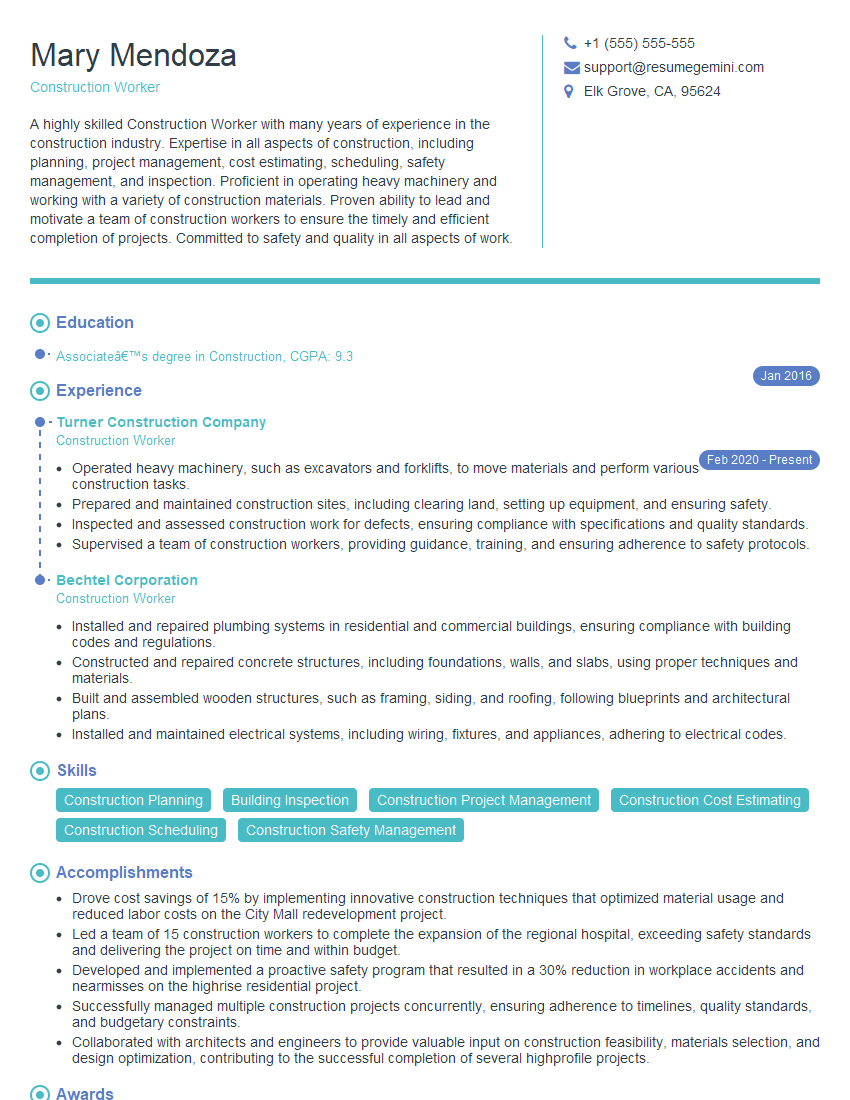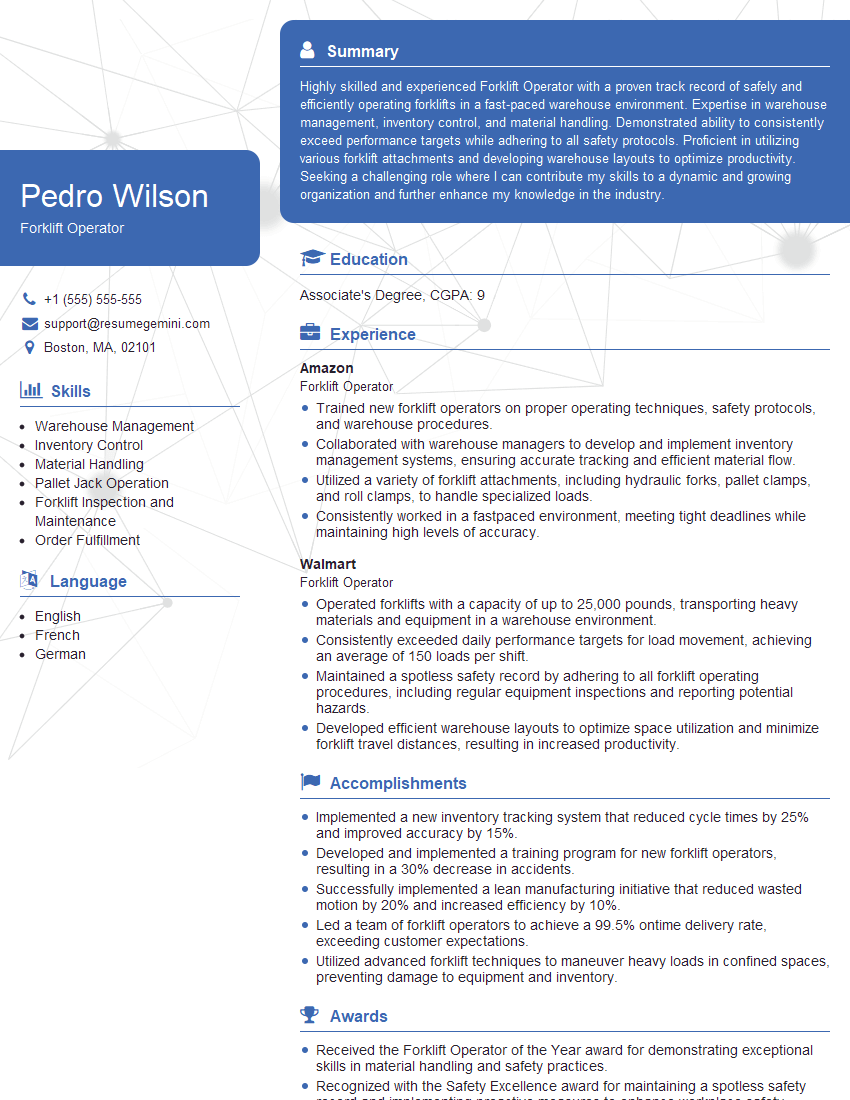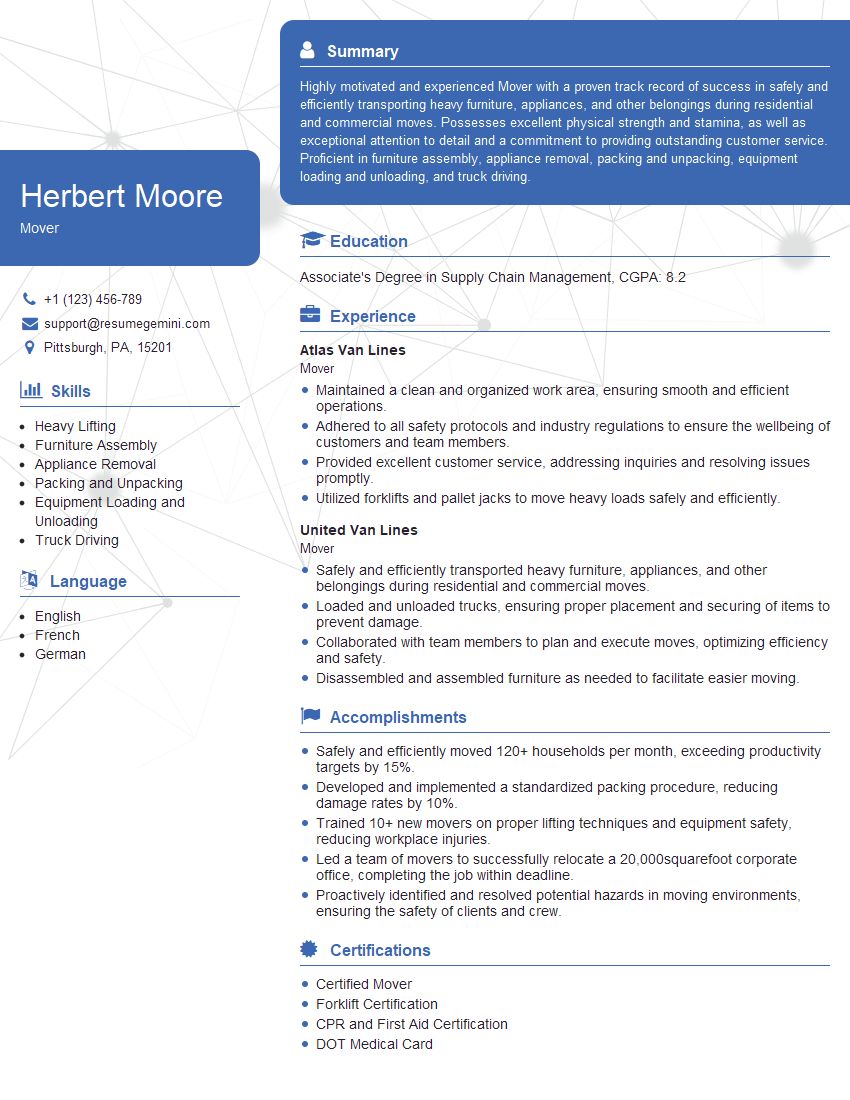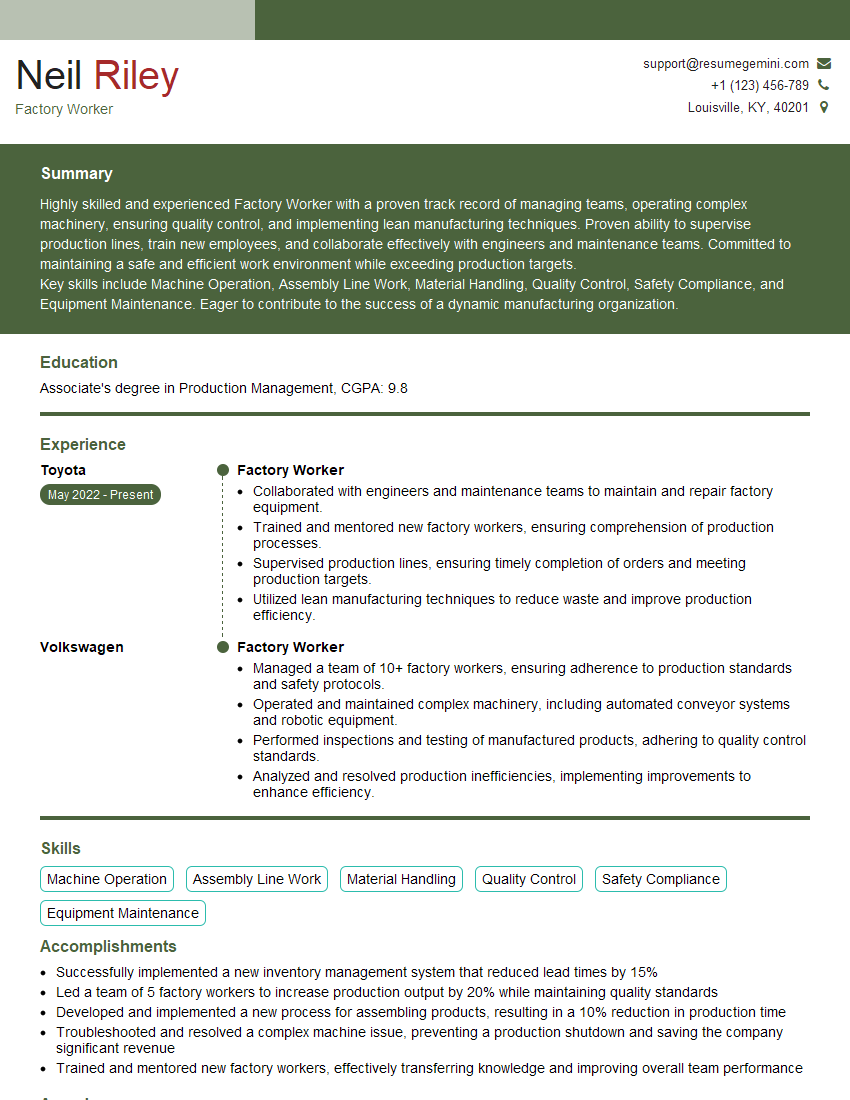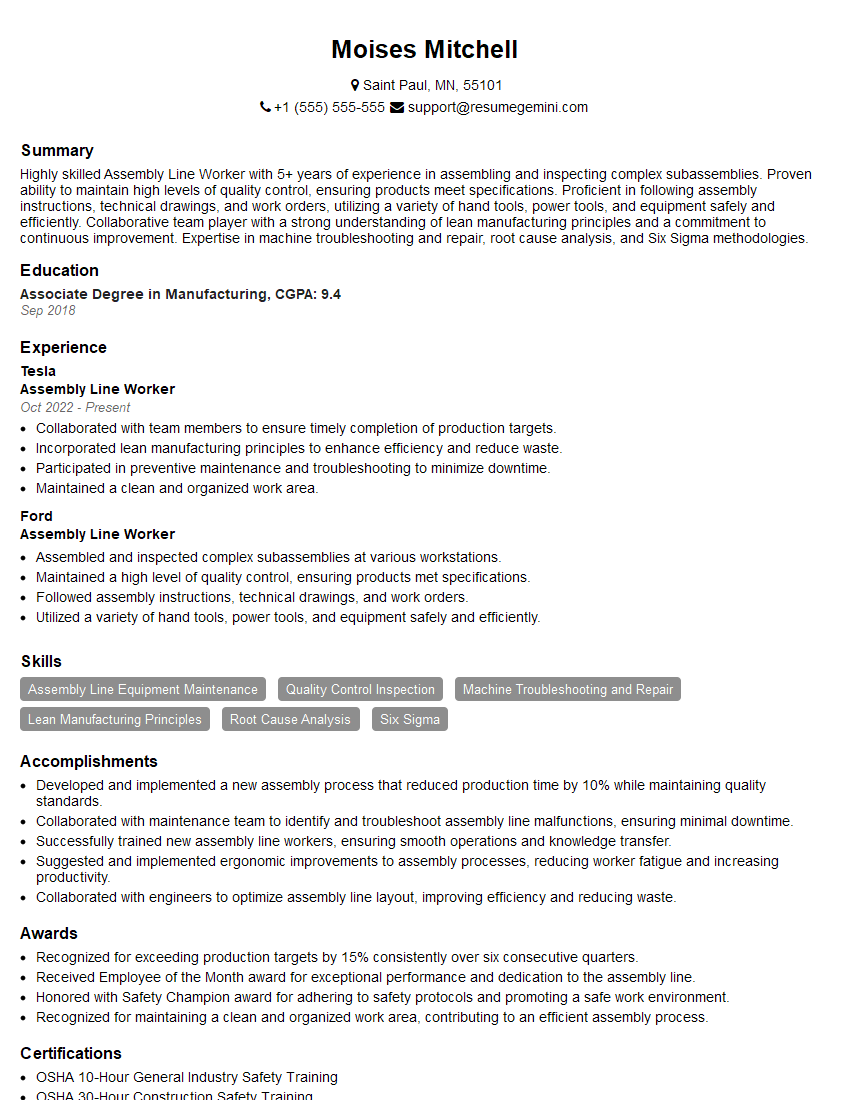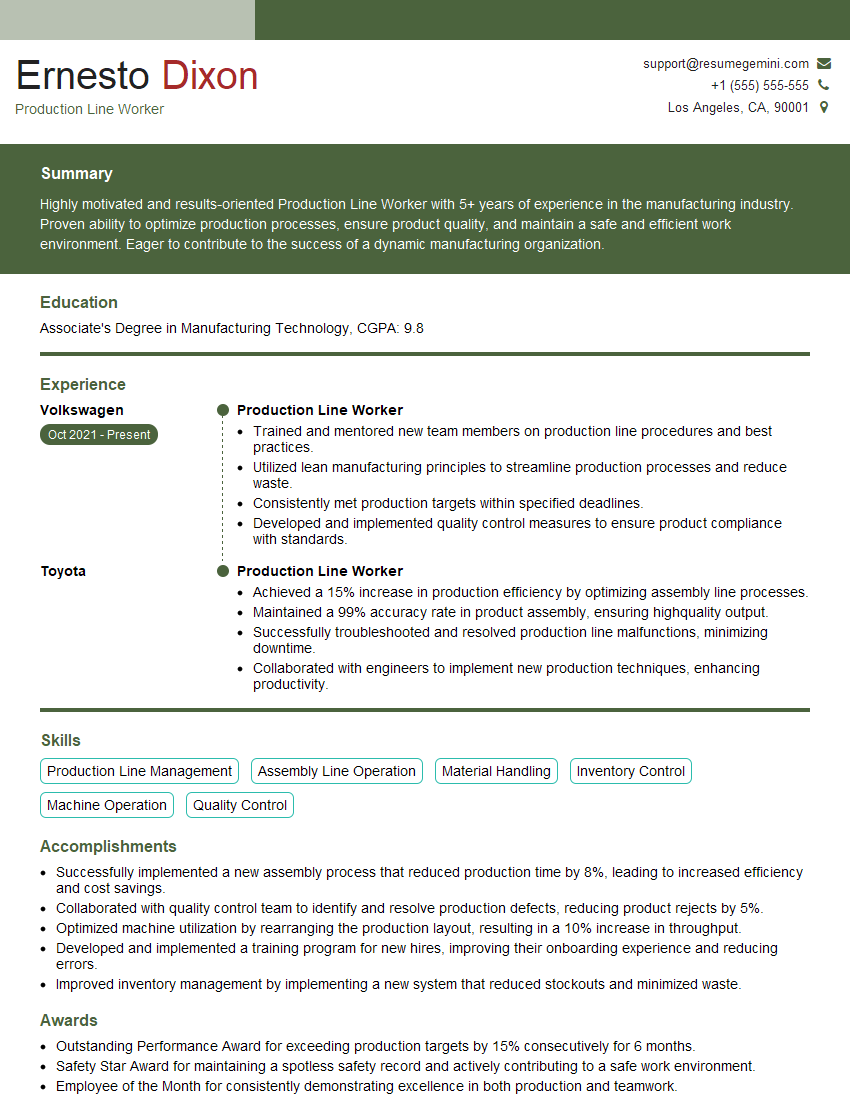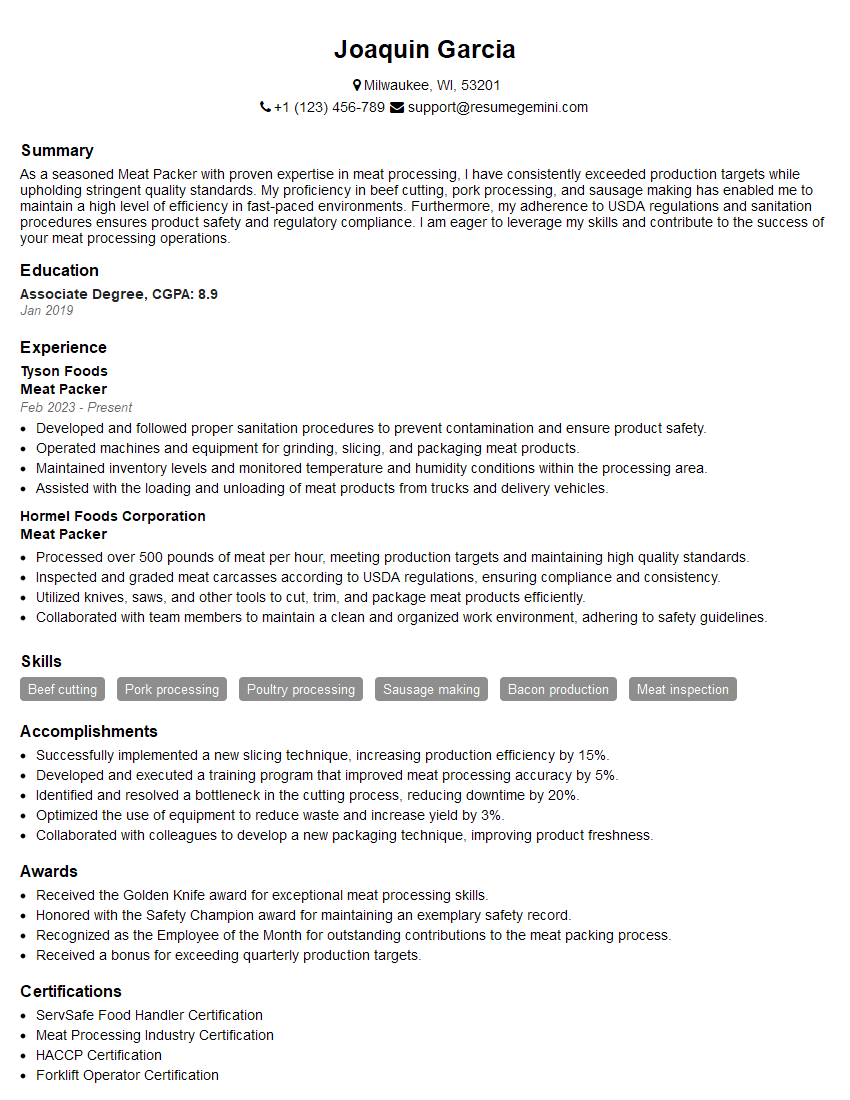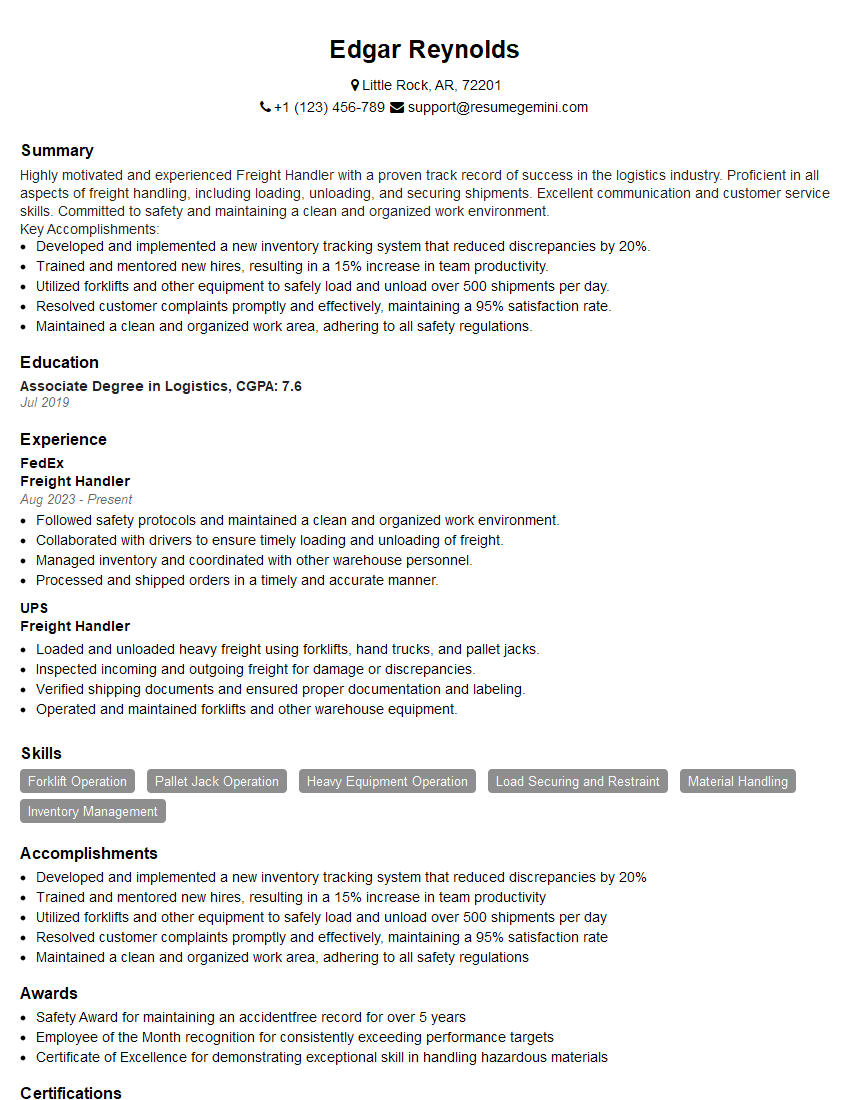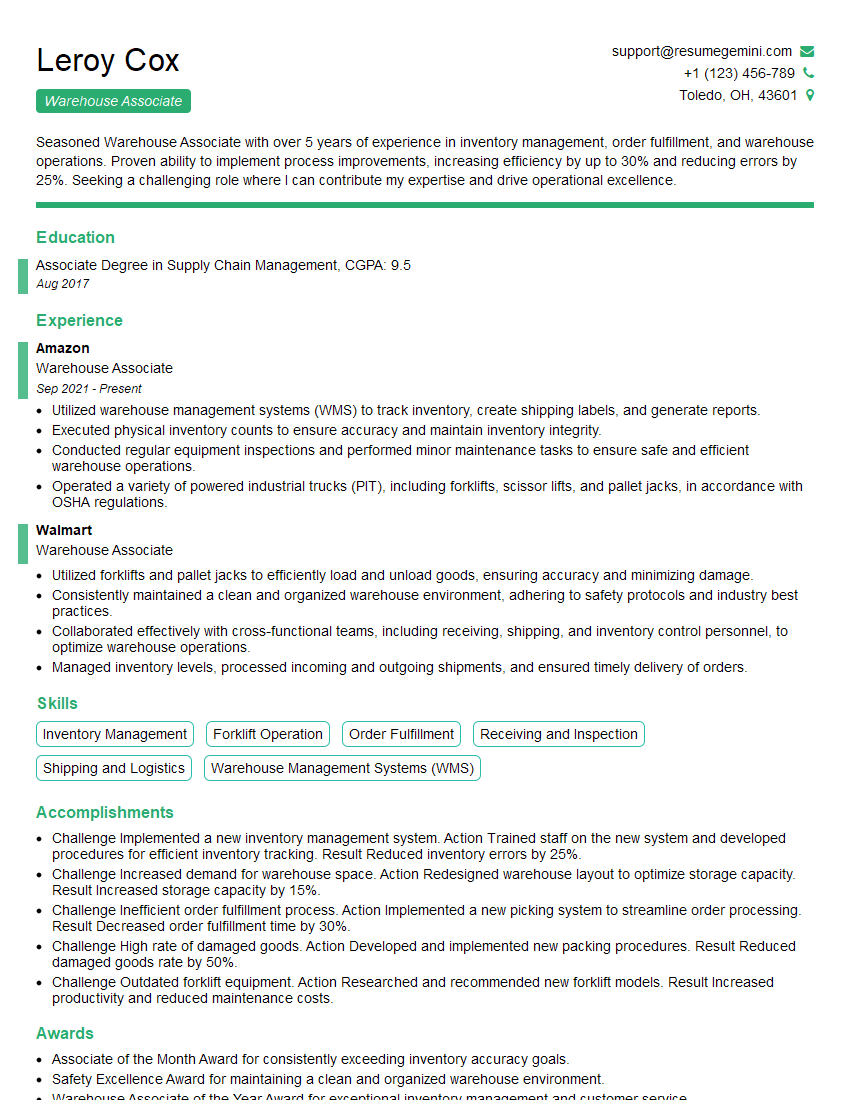Preparation is the key to success in any interview. In this post, we’ll explore crucial Ability to lift heavy objects and stand for extended periods interview questions and equip you with strategies to craft impactful answers. Whether you’re a beginner or a pro, these tips will elevate your preparation.
Questions Asked in Ability to lift heavy objects and stand for extended periods Interview
Q 1. Describe your experience lifting objects weighing over 50 pounds.
Throughout my career, I’ve consistently lifted objects exceeding 50 pounds, often in warehouse and manufacturing settings. This involved a range of tasks, from moving boxes of inventory to handling heavier machinery components. For example, in my previous role at Acme Manufacturing, I regularly lifted and positioned 75-pound engine blocks onto assembly lines. This required careful planning and adherence to safe lifting techniques to avoid injury. Another instance involved maneuvering 60-pound sacks of raw materials onto a conveyor belt. Consistent practice of proper lifting techniques has enabled me to perform these tasks efficiently and safely over many years.
Q 2. What techniques do you use to safely lift heavy objects?
Safe lifting is paramount. My technique always begins with assessing the weight and stability of the object. I ensure a clear path is available, removing any obstacles that might cause tripping or stumbling. Then, I get as close as possible to the object, maintaining a stable base of support with my feet shoulder-width apart. Bending at my knees and hips, I firmly grasp the object, keeping it close to my body, avoiding twisting movements. I lift smoothly using my leg muscles and avoiding jerky motions. Finally, I place the object down carefully, following the reverse process. Think of it like this: your legs are the power, your core is the stability, and your back remains straight to avoid strain.
Q 3. Explain how you manage fatigue when standing for extended periods.
Managing fatigue during prolonged standing is crucial for preventing injury. I utilize several strategies. Firstly, I ensure I have appropriate footwear with good support and cushioning. Secondly, I practice regular micro-breaks – shifting my weight, stretching my legs and back, and taking short walks. Furthermore, I maintain good posture to distribute weight evenly and avoid unnecessary strain. In situations where prolonged standing is unavoidable, using anti-fatigue mats provides added comfort and support. Staying hydrated is also key, as dehydration can exacerbate fatigue. I find that regular breaks and conscious attention to posture are hugely effective.
Q 4. Have you ever experienced a workplace injury related to lifting or standing? How was it handled?
Yes, early in my career I strained my back while improperly lifting a heavy crate. It taught me a valuable lesson. The injury was reported immediately to my supervisor, and I received prompt medical attention. The company initiated a thorough investigation of the incident, leading to improvements in safety procedures, including mandatory safety training. I subsequently received physical therapy and gradually returned to work with modified duties, focusing on a slow and steady recovery. This experience reinforced the importance of following safety protocols and the value of a supportive work environment.
Q 5. How do you prioritize safety when lifting heavy items in a fast-paced environment?
In fast-paced settings, prioritizing safety requires preemptive measures. This includes pre-planning each lift, ensuring there’s enough time to perform the lift safely, and not rushing. I communicate with my colleagues to ensure smooth workflow and avoid collisions. If a lift is beyond my capacity, I immediately seek assistance rather than risking injury. I continuously evaluate the environment for hazards, ensuring the work area is clean and uncluttered. Remember, speed shouldn’t compromise safety; efficient and safe work practices ultimately enhance productivity in the long run.
Q 6. What are the ergonomic principles you follow to prevent injury?
Ergonomic principles are at the core of my approach. I always maintain good posture, keeping my back straight and lifting with my legs, not my back. I avoid twisting motions, and ensure the object is within comfortable reach. I use appropriate lifting aids when available, such as dollies or hand trucks, and frequently take breaks to avoid fatigue. Applying ergonomic principles isn’t just about avoiding immediate injury; it’s about long-term health and well-being, ensuring I can continue performing my duties efficiently and effectively for years to come.
Q 7. Describe a situation where you had to lift an unusually heavy object. What steps did you take?
During a warehouse relocation, we encountered a pallet of unusually heavy equipment, significantly heavier than our usual loads. Instead of attempting to move it alone, we immediately called for assistance and secured the appropriate equipment, using a forklift to move the heavy pallet safely. We also ensured everyone understood the lift plan before starting the operation, assigning clear roles and responsibilities to avoid any accidents. Teamwork and proper equipment were crucial in navigating this challenging situation. The emphasis wasn’t on speed, but on a safe and efficient move.
Q 8. How do you maintain physical fitness to meet the demands of a physically demanding job?
Maintaining physical fitness for a physically demanding job requires a holistic approach. It’s not just about brute strength, but also endurance, flexibility, and injury prevention. My routine focuses on three key areas:
- Strength Training: I incorporate regular strength training exercises targeting major muscle groups like legs, back, core, and shoulders. This builds the muscle mass needed for lifting and reduces the risk of injury. For example, squats, deadlifts (with proper form!), and rows are crucial.
- Cardiovascular Exercise: Cardiovascular fitness is essential for endurance. Activities like running, swimming, or cycling improve stamina, allowing me to stand and work for extended periods without excessive fatigue.
- Flexibility and Mobility: Stretching and mobility exercises are crucial for preventing injuries. Regular stretching keeps muscles flexible and prevents stiffness, which is particularly important after prolonged standing. I focus on dynamic stretches before activity and static stretches afterward.
I also prioritize sufficient sleep, a balanced diet rich in protein for muscle repair, and proper hydration. Regular check-ups with my physician ensure I’m addressing any potential health concerns proactively.
Q 9. What strategies do you use to conserve energy while standing for prolonged periods?
Conserving energy while standing for long periods involves a combination of techniques focused on posture, movement, and breaks. Imagine standing as a marathon, not a sprint.
- Proper Posture: Maintaining good posture – feet shoulder-width apart, slight bend in the knees, and engaging core muscles – distributes weight evenly, reducing strain. Think of it like distributing the weight of a backpack evenly across your shoulders.
- Micro-movements: Instead of staying completely still, I make small, subtle shifts in weight from one foot to the other. This keeps blood flowing and reduces muscle fatigue. Think of it as a very slow, controlled dance.
- Strategic Breaks: Regular short breaks are crucial. Even a few minutes of sitting or walking around can significantly reduce fatigue. This allows muscles to rest and recover.
- Supportive Footwear: Wearing comfortable, supportive shoes with good arch support is essential. Poor footwear can exacerbate fatigue and contribute to foot and back problems.
By combining these strategies, I can significantly extend my ability to stand and work comfortably throughout the day.
Q 10. How would you react if you witness a coworker using unsafe lifting techniques?
Witnessing a coworker using unsafe lifting techniques is a serious safety concern. My immediate response would be to intervene respectfully but firmly.
- Approach with Concern: I would approach the coworker privately and express my concern in a non-judgmental way, focusing on safety. Something like, ‘Hey [Coworker’s Name], I noticed you lifting that [object] just now. I wanted to mention that I’ve had training on safe lifting techniques, and I’m concerned you might injure yourself. Could I show you a safer way?’
- Demonstrate Proper Technique: I would then demonstrate the correct lifting technique, emphasizing proper posture, foot placement, and using leg muscles instead of the back.
- Report to Supervisor (If Necessary): If the coworker continues to use unsafe techniques or if I feel uncomfortable addressing the issue directly, I would report the situation to my supervisor to ensure everyone’s safety. The goal is to prevent potential injuries.
Safety is paramount, and addressing unsafe practices promptly is crucial for maintaining a healthy and productive work environment.
Q 11. What is your experience with using lifting aids or equipment (e.g., pallet jacks, forklifts)?
I have extensive experience using various lifting aids and equipment. My experience includes:
- Pallet Jacks: I’m proficient in operating pallet jacks, understanding their limitations and safe operating procedures. This includes proper loading, maneuvering in tight spaces, and ensuring the load is stable.
- Forklifts (with certification): I possess a valid forklift certification, demonstrating my competency in safely operating forklifts, conducting pre-operational checks, and adhering to all safety regulations.
- Other Lifting Aids: I’m familiar with and have used other lifting aids such as hand trucks, come-alongs, and lifting straps, always prioritizing safety and proper techniques.
My experience encompasses not only the operation of these machines but also their maintenance and identification of potential safety hazards.
Q 12. How familiar are you with workplace safety regulations related to lifting and material handling?
I am very familiar with workplace safety regulations related to lifting and material handling. My knowledge includes:
- OSHA Regulations (or equivalent): I understand the relevant OSHA (Occupational Safety and Health Administration) guidelines or equivalent regulations in my region concerning lifting limits, proper lifting techniques, and the use of personal protective equipment (PPE).
- Company-Specific Policies: I am aware of and adhere to our company’s specific policies regarding material handling, including procedures for reporting near misses and injuries.
- Hazard Identification and Risk Assessment: I’m trained to identify potential hazards related to lifting and material handling and to assess the risks associated with various tasks. This includes understanding how to perform a thorough risk assessment before beginning a potentially hazardous task.
Staying updated on these regulations is an ongoing process, and I actively participate in safety training to ensure I maintain my knowledge and comply with all current standards.
Q 13. How do you adapt your lifting techniques to different object sizes and shapes?
Adapting lifting techniques to different object sizes and shapes is essential for preventing injuries. The key is to maintain a stable base and use proper body mechanics, regardless of the object’s characteristics.
- Size: For larger objects, I might need to use lifting aids, break the load into smaller, more manageable pieces, or get assistance from coworkers.
- Shape: Irregular shapes require careful assessment to ensure a secure grip and a balanced lift. I might need to use additional support, such as straps or lifting aids, to control the object during the lift. Using gloves for improved grip may be necessary.
- Weight Distribution: Always try to keep the load close to the body to reduce strain. If the weight is unevenly distributed, you should use additional support or request help.
Before lifting anything, I always assess the object’s weight, size, and shape and adjust my technique accordingly. Safety is the priority and I will not attempt a lift if I am unsure I can do it safely.
Q 14. How do you assess the weight of an object before attempting to lift it?
Assessing the weight of an object before lifting is crucial for preventing injury. There are several ways to do this:
- Visual Inspection: I start by visually assessing the object’s size and apparent weight. Experience helps me to estimate the weight based on its size and material.
- Physical Estimation (Careful): I might try to gently move or lift a corner of the object to get a sense of its weight before committing to a full lift. This is a subtle ‘test’ to help gauge it.
- Using Lifting Aids: If the weight is unclear, or the object is heavy, I will use lifting aids. This eliminates the guesswork and ensures the safety of the lift.
- Asking for Help: If I’m unsure of the weight, or if the object seems too heavy, I will always ask for assistance from a coworker. Safety in numbers is better.
Remember, it’s always better to err on the side of caution. If you’re unsure, don’t lift it alone. Get help, and use appropriate equipment.
Q 15. What are the signs of overexertion, and how do you respond to them?
Overexertion occurs when your body’s physical demands exceed its capacity. Signs can range from mild to severe. Mild signs include muscle fatigue, soreness, and increased heart rate. More severe signs might include intense pain, muscle cramps, dizziness, nausea, or shortness of breath. In some cases, you might even experience weakness or trembling.
My response to overexertion always prioritizes safety. If I experience mild symptoms, I’ll slow down, take breaks, and hydrate. I’ll also try to adjust my posture and lifting technique to reduce strain. However, if I experience severe symptoms, I immediately stop the activity, report the issue to my supervisor, and seek medical attention if necessary. I believe prevention is key, so I also focus on maintaining good physical fitness and practicing proper lifting techniques to avoid overexertion in the first place.
For example, during a particularly busy shift moving heavy boxes, I felt a sharp pain in my lower back. Instead of pushing through, I immediately stopped, stretched, and informed my supervisor. After a short rest and some ice, I felt better and was able to resume my duties more cautiously.
Career Expert Tips:
- Ace those interviews! Prepare effectively by reviewing the Top 50 Most Common Interview Questions on ResumeGemini.
- Navigate your job search with confidence! Explore a wide range of Career Tips on ResumeGemini. Learn about common challenges and recommendations to overcome them.
- Craft the perfect resume! Master the Art of Resume Writing with ResumeGemini’s guide. Showcase your unique qualifications and achievements effectively.
- Don’t miss out on holiday savings! Build your dream resume with ResumeGemini’s ATS optimized templates.
Q 16. How do you communicate potential lifting hazards to your supervisors?
Communicating potential lifting hazards is crucial for a safe work environment. I always promptly inform my supervisors about any unsafe conditions I encounter. My approach is straightforward and detailed. I describe the specific hazard (e.g., “The boxes are inconsistently stacked, making them unstable and difficult to lift safely,” or “The floor is uneven, increasing the risk of slips and strains during lifting”), its location, and the potential consequences (e.g., “This could lead to back injuries or dropped loads”). I also suggest practical solutions, such as better stacking methods or using appropriate lifting equipment.
For instance, if I notice improperly secured loads on a pallet, I wouldn’t just mention it casually; I’d explain the risk of the load shifting and recommend using straps or additional bracing to secure it. Clear and concise communication is key to preventing accidents.
Q 17. How do you manage pain or discomfort from prolonged standing or lifting?
Managing pain from prolonged standing or lifting involves a multi-faceted approach. I prioritize preventative measures such as regular stretching, maintaining good posture, and utilizing ergonomic tools whenever possible. During the workday, I take frequent short breaks to move around, stretch my legs and back, and change positions to relieve pressure points.
If pain persists despite these measures, I might use over-the-counter pain relievers (like ibuprofen) as directed. Additionally, I regularly incorporate physical activities, such as yoga or walking, outside of work to improve my flexibility and endurance. Persistent or severe pain is always reported to my supervisor and a healthcare professional for proper diagnosis and treatment. I believe in proactive pain management, not just reactive treatment.
Q 18. Describe your experience working in a physically demanding environment.
I’ve worked in physically demanding environments for [Number] years, primarily in [Industry/Job Title]. This experience has given me a deep understanding of the physical challenges involved and the importance of safety protocols. I’ve handled everything from [example task 1] to [example task 2], consistently prioritizing safety and efficiency. One memorable project involved [brief description of a challenging project and how you overcame it, highlighting your physical stamina and problem-solving skills]. This experience reinforced the importance of teamwork, proper lifting techniques, and the need for regular breaks to avoid injury.
I’ve learned to pace myself, listen to my body, and utilize available resources like lifting equipment and team assistance when necessary. My work ethic is strong, and I consistently go above and beyond to complete tasks, but always within the bounds of safe working practices. My experience has taught me the value of preventive care and the importance of reporting any concerns promptly.
Q 19. What is your understanding of proper body mechanics for lifting?
Proper body mechanics for lifting are fundamental to preventing injuries. The core principles involve maintaining a stable base, keeping the load close to your body, bending your knees, and lifting with your legs, not your back. This avoids excessive strain on the spine and other joints.
- Assess the load: Before lifting, evaluate the weight and size of the object to ensure you can lift it safely. If it’s too heavy, seek assistance.
- Proper stance: Position yourself squarely in front of the object, feet shoulder-width apart, with one foot slightly ahead of the other for balance.
- Bend your knees: Squat down, keeping your back straight, and grasp the object firmly.
- Lift with your legs: Straighten your legs, using the power of your leg muscles to lift the object. Keep the load close to your body to minimize strain on your back.
- Maintain posture: Avoid twisting or reaching while lifting. Turn your feet and body to change direction.
- Set down carefully: Lower the object slowly, using your leg muscles to control the descent.
Think of it like this: imagine lifting a heavy box using only your back—it’s a recipe for disaster. Lifting with your legs is like using a powerful lever; it distributes the weight effectively and minimizes strain.
Q 20. How do you adjust your work practices to accommodate physical limitations?
Accommodating physical limitations requires careful planning and adjustments. I regularly self-assess my physical capacity and adjust my work practices accordingly. This involves prioritizing tasks, using assistive devices when appropriate, and seeking help from colleagues when needed. If I experience persistent pain or limitations, I communicate these issues to my supervisor, so we can explore reasonable accommodations, such as modified work schedules or different task assignments. I’m proactive in seeking solutions that maintain my productivity while safeguarding my health.
For example, if I experience knee pain, I might use a hand truck for transporting heavy items or modify my lifting technique to reduce strain on my knees. I also ensure that I take extra breaks and stretch regularly to prevent further injury.
Q 21. How would you handle a situation where a heavy object is unexpectedly dropped?
If a heavy object is unexpectedly dropped, my immediate response is to protect myself and others from harm. I’d move quickly but carefully to a safe distance, alerting those nearby to the danger. Then I would assess the situation: is anyone injured? Is there further danger (e.g., potential for further falling objects)?
Once the immediate danger is past, I would report the incident to my supervisor, document what happened, and assist in the cleanup process, ensuring that the area is safe for others. I’d also try to determine the cause of the dropped object (e.g., improper handling, equipment failure) to prevent similar incidents in the future. This requires teamwork and a focus on preventative measures.
Q 22. What are the common causes of workplace injuries related to lifting and standing?
Workplace injuries related to lifting and standing are often caused by a combination of factors. Poor posture, improper lifting techniques, and exceeding physical limits are major culprits. Let’s break it down:
- Musculoskeletal Disorders (MSDs): These are injuries to muscles, tendons, ligaments, nerves, and joints. They frequently result from repetitive movements, awkward postures (like twisting while lifting), and excessive force. Think of back pain, carpal tunnel syndrome, and rotator cuff injuries.
- Overexertion Injuries: These occur when individuals attempt to lift or carry objects exceeding their physical capabilities. This leads to strains, sprains, and even hernias.
- Falls: Fatigue from prolonged standing can lead to decreased balance and increased risk of falls, especially on uneven surfaces or in cluttered workspaces.
- Environmental Factors: Slippery floors, inadequate lighting, and poor workplace design can all contribute to lifting and standing related injuries.
- Lack of Training: Insufficient training on proper lifting techniques and ergonomic principles significantly increases the risk of injury.
For example, a warehouse worker repeatedly lifting heavy boxes without proper technique might develop chronic back pain, while a cashier standing for eight hours daily with poor posture could experience leg pain and fatigue.
Q 23. How do you ensure you maintain proper posture while standing and lifting?
Maintaining proper posture while standing and lifting is crucial for injury prevention. It’s all about minimizing strain on your back, neck, and joints. Here’s my approach:
- Standing: I ensure my feet are shoulder-width apart, knees slightly bent, and my back straight, avoiding slouching. I regularly shift my weight and take short breaks to prevent fatigue. Imagine a string gently pulling you upwards from the crown of your head.
- Lifting: Before lifting, I assess the weight and plan my lift. I get close to the object, bend my knees, keeping my back straight, and lift using my leg muscles, not my back. I keep the object close to my body and avoid twisting. I never lift more than I can safely handle, and if it’s too heavy, I always seek assistance.
For example, imagine lifting a heavy filing cabinet. I wouldn’t try to yank it up from a distance. Instead, I’d get close, bend my knees, grip it firmly, and use my leg muscles to slowly lift it upright, keeping my back as straight as possible.
Q 24. What safety precautions would you take when lifting in a confined space?
Lifting in confined spaces presents additional challenges and necessitates extra safety precautions. Here’s my strategy:
- Assess the Space: Before starting, I thoroughly evaluate the space for obstructions, hazards, and sufficient room for movement. I check for poor lighting and ensure adequate ventilation.
- Use Appropriate Equipment: If possible, I would use specialized lifting equipment designed for confined spaces, such as smaller, maneuverable hoists or lifting slings.
- Teamwork: If lifting a heavy object alone is not feasible or safe, I would collaborate with a team to ensure a coordinated and safe lift.
- Communication: Clear and constant communication is vital within a team to coordinate movements and prevent accidents.
- Personal Protective Equipment (PPE): I’d always wear appropriate PPE, including gloves, safety shoes, and possibly a helmet if there’s a risk of falling objects.
- Spotter: Have someone act as a spotter to guide and assist, and to alert you of any potential dangers.
For instance, imagine lifting heavy equipment into a small elevator. I would ensure the elevator has enough capacity, coordinate with the team, and use appropriate hand signals to ensure a smooth and safe lift. I’d also make sure the elevator door is secure.
Q 25. Describe a time you had to improvise a solution to lift a heavy object without the usual equipment.
During a move, we needed to lift a very heavy antique desk up a narrow staircase. We lacked the usual equipment like dollies. We improvised by using sturdy, long planks of wood as ramps and strong ropes. We secured the desk to the ropes, creating a makeshift system to guide the desk safely up the stairs, using multiple people to control the descent and movement of the desk.
This involved teamwork, clear communication, and careful planning. We adjusted the ropes at each step, ensuring that the desk’s weight was distributed evenly to avoid tipping or damage.
Q 26. How do you prioritize safety versus speed when dealing with heavy lifting tasks?
Safety always trumps speed. While efficiency is important, rushing a heavy lifting task significantly increases the risk of injury. My priority is always to perform the task safely, even if it takes a little longer. I’d rather be slightly slower and injury-free than fast and injured.
This involves careful planning, using appropriate equipment, and adhering to established safety protocols. If speed is a factor, I would consider alternative methods or seek assistance. For example, I would rather wait for a forklift to move a pallet of materials rather than risk injuring myself by trying to manually move it quickly.
Q 27. How familiar are you with different types of lifting equipment and their safety procedures?
I’m familiar with a range of lifting equipment, including:
- Hand Trucks/Dollies: For moving bulky or heavy objects over short distances.
- Forklifts: For transporting pallets and heavier loads.
- Overhead Cranes: For lifting extremely heavy objects.
- Hoists: For lifting heavy objects vertically.
- Lifting Straps/Slings: To secure loads for safe lifting.
I understand the safety procedures for each type of equipment. This includes pre-use inspections, safe operating procedures, load limits, and proper securing techniques. For example, before operating a forklift, I’d always check the fluid levels, tire pressure, and ensure that the load is evenly distributed and properly secured to prevent accidents.
Key Topics to Learn for Ability to lift heavy objects and stand for extended periods Interview
- Proper Lifting Techniques: Understanding and demonstrating knowledge of safe lifting mechanics to minimize injury risk. This includes proper posture, foot placement, and the use of lifting aids when appropriate.
- Body Mechanics and Ergonomics: Applying principles of body mechanics to efficiently and safely perform tasks requiring prolonged standing and heavy lifting. This includes understanding how to distribute weight, maintain balance, and avoid strain.
- Safety Procedures and Regulations: Familiarity with workplace safety regulations and procedures related to material handling and physical demands. This could involve understanding workplace hazard assessments and personal protective equipment (PPE) usage.
- Stamina and Endurance: Demonstrating an understanding of how to maintain physical fitness and stamina for roles requiring extended periods of standing and repetitive lifting. This could involve discussing healthy lifestyle choices and strategies for managing fatigue.
- Communication and Teamwork: Highlighting the importance of effective communication with colleagues regarding lifting assistance, safety concerns, and workload management when undertaking physically demanding tasks.
- Adaptability and Problem Solving: Explaining how you would adapt to varying physical demands and solve problems related to lifting heavy objects or maintaining stamina throughout a long shift.
Next Steps
Mastering the ability to lift heavy objects and stand for extended periods is crucial for career advancement in many physically demanding fields. It demonstrates your commitment to safety, efficiency, and your overall capability. To significantly increase your job prospects, crafting an ATS-friendly resume that highlights these skills is essential. ResumeGemini is a trusted resource to help you build a professional and effective resume tailored to showcase your abilities. We provide examples of resumes specifically designed for roles requiring these physical capabilities, helping you present yourself in the best possible light to potential employers.
Explore more articles
Users Rating of Our Blogs
Share Your Experience
We value your feedback! Please rate our content and share your thoughts (optional).
What Readers Say About Our Blog
Hello,
We found issues with your domain’s email setup that may be sending your messages to spam or blocking them completely. InboxShield Mini shows you how to fix it in minutes — no tech skills required.
Scan your domain now for details: https://inboxshield-mini.com/
— Adam @ InboxShield Mini
Reply STOP to unsubscribe
Hi, are you owner of interviewgemini.com? What if I told you I could help you find extra time in your schedule, reconnect with leads you didn’t even realize you missed, and bring in more “I want to work with you” conversations, without increasing your ad spend or hiring a full-time employee?
All with a flexible, budget-friendly service that could easily pay for itself. Sounds good?
Would it be nice to jump on a quick 10-minute call so I can show you exactly how we make this work?
Best,
Hapei
Marketing Director
Hey, I know you’re the owner of interviewgemini.com. I’ll be quick.
Fundraising for your business is tough and time-consuming. We make it easier by guaranteeing two private investor meetings each month, for six months. No demos, no pitch events – just direct introductions to active investors matched to your startup.
If youR17;re raising, this could help you build real momentum. Want me to send more info?
Hi, I represent an SEO company that specialises in getting you AI citations and higher rankings on Google. I’d like to offer you a 100% free SEO audit for your website. Would you be interested?
Hi, I represent an SEO company that specialises in getting you AI citations and higher rankings on Google. I’d like to offer you a 100% free SEO audit for your website. Would you be interested?
good

